Heading out the door? Read this article on the new Outside+ app available now on iOS devices for members! Download the app.
Whether you’re triggering an emergency SOS signal, messaging a fellow backcountry traveler to coordinate a meetup, or simply letting folks at home know you’ll be late for dinner, satellite communicators allow us to stay out longer and get back safely. The very best in the category work reliably, have simple interfaces, and don’t take up much room in our packs. These are the five best devices on the market today.
At a Glance
- Editors’ Choice: Garmin inReach Messenger Plus ($500)
- Best Standalone: Spot X ($250)
- Best Subscription-Free: ACR ResQLink View ($485-$728)
- Best Budget: Zoleo Communicator ($200)
- Best for Groups: ACR Bivy Stick Mesh ($300)
- Other Devices We Tested
- How to Choose a Satellite Communicator
- How We Test
- Meet Our Lead Tester
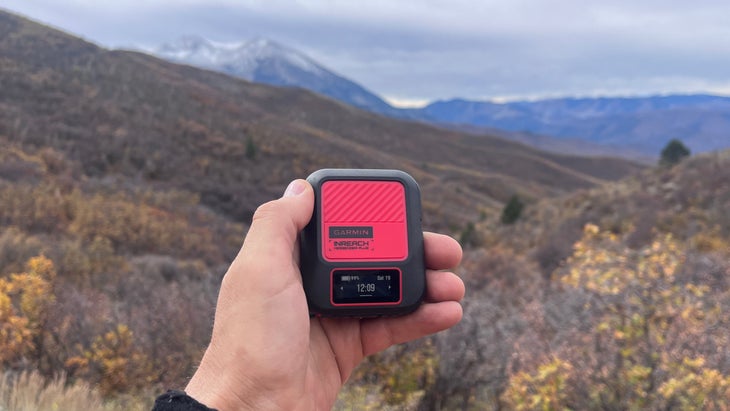
Editors’ Choice
Garmin inReach Messenger Plus
$500 at REI $500 at Backcountry
Weight: 4.1 oz
Pros and Cons:
⊕ Fastest messaging speeds in test
⊕ Ability to send photos and voice memos
⊕ Reverse-charging
⊗ Tiny screen
⊗ Expensive
Garmin’s inReach Mini and Messenger lines have dominated the category since 2018—the tiny orange gizmo is a common sight on long trails all over the country. And while previous iterations were category-leading, the brand’s new Messenger Plus is a full evolution for satellite messengers. It allows users to send 1,600-character messages (the previous limit on Garmin devices was 160) as well as photos and voice memos when connected to the Garmin Messenger app on your smartphone. All that, and it still packs down to the same dimensions as the previous inReach Messenger (3.1 x 2.5 x 0.9 inches) and weighs only four grams more at 4.1 ounces.
Testers in the West Elk mountains of Colorado noticed that the new device sends long-winded missives exceptionally fast, in mere seconds rather than over a minute as is sometimes the case with older devices and competitors that break up longer texts into multiple messages. And it’s not just text—the Messenger Plus sent compressed photos and 30-second voice memos with a transcript to friends and family back home in just a few seconds as well. As nice as it is to share the scenery with loved ones, the ability to send photos is also a critical feature for first responders who need as much detail as possible to facilitate a rescue. (Important note: the person on the receiving end also needs the Garmin Messenger app to view photos and voice memos, but text messages will go through just fine without it.)
What’s the magic sauce behind Garmin’s larger file size transfers and zippy speeds? Thanks to significant hardware and software upgrades, the device is able to use something called the Iridium Short Burst Data system, which sends messages approximately 300 times larger than the previous Messenger. We can only assume such tech will be available on future inReach devices, as well.
The Messenger and Explore apps are easy to use, with the former focusing on communication and the latter offering GPS navigation and topographic maps. We generally stick to the Messenger app for simplicity, and rely on a smartphone app like Gaia GPS for navigation. The device itself, with only five buttons and a miniscule screen, is surprisingly navigable: you can punch out preset texts as well as messages by individual character with just as much ease as on the larger InReach Mini 2.
The impressive 600-hour battery life (on low power) provides enough juice to send 250 photos or voice memos, and can even reverse-charge your smartphone in a pinch, at least until the Messenger Plus’s battery drops to 25 percent.
Garmin’s subscription plans range from $15 to $50 for inReach devices, with the cheaper plans offering nearly twice as many messages as other competitors on this list. The more expensive plans cost about the same as other competitors.
At $500, the Messenger Plus doesn’t come cheap. But for those who will put its speed, photo, and voice features to regular use (or want an extra level of emergency communication capability), you won’t find a better satellite messenger on the market.
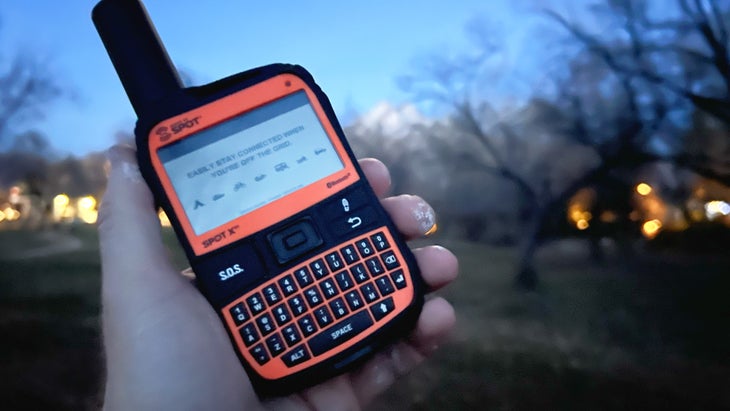
Best Standalone
SPOT X
$250 at REI $250 at Backcountry
Weight: 7 oz
Pros and Cons:
⊕ Full physical keyboard
⊕ Dedicated phone number
⊕ Relatively cheap
⊗ Relatively heavy and bulky
⊗ Poor coverage
⊗ Buttons are small and clunky
SPOT has been a legacy player in the satellite communication game since the early 2000s when it created the first reasonably priced personal locator beacon (PLB) for consumers. It still operates on the Globalstar network (as opposed to the Iridium Network like several other devices in this roundup), which means it has less extensive coverage, especially outside of North American, European, and Australian locations. In general, SPOT doesn’t lead the charge in terms of innovation, but the SPOT X with Bluetooth has some key features that set it apart from the mostly smartphone-reliant options on the market.
SPOT X has a dedicated U.S. phone number, so our testers were able to both send and receive text messages to and from standard mobile phones and other two-way satellite messengers. Outgoing messages from some other devices, including older Garmins without the Messenger app, show up on the recipient’s phone from a temporary, unknown number. SPOT X users need not worry about confusing their text recipients, who can initiate contact to the known number.
The rugged, physical QWERTY keyboard helped make the SPOT X the prime choice among our “unplugged” testers who either don’t have a smartphone or prefer to leave it behind when seeking solace in nature, but still want an emergency lifeline beyond the ACR-style emergency beacon. The buttons are small, and not the easiest to use, but will feel intuitive for older generations who lived through the early 2000s QWERTY cell phone boom (remember Blackberries?). While clunky, it gets the job done faster than keyboard-less options.
Annual subscription plans are pretty standard at 20 messages per month for $12, 100 for $20, and unlimited for $30, with a flexible option for a one-month commitment for just a few dollars more.
Ding? The SPOT X smartphone app is glitchy and not frequently updated—you’re better off going analog with this one.
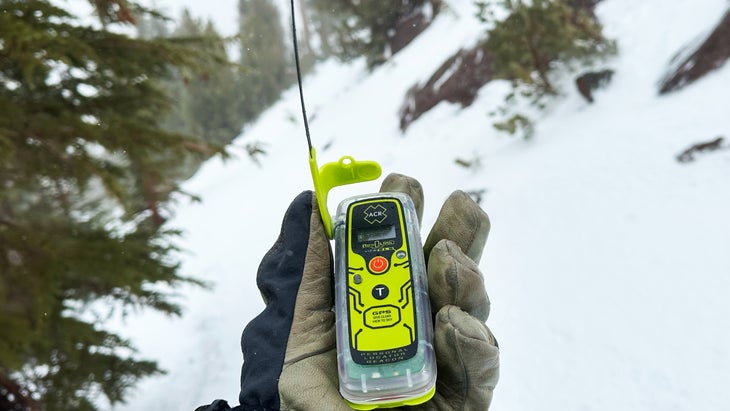
Best Subscription-Free
ACR ResQLink View RLS
Weight: 5.2 oz
Pros and Cons:
⊕ Simple, straightforward design
⊕ No setup or pairing required
⊕ Buoyant and waterproof
⊗ Antennae kit can easily pop out of its slot
⊗ No smartphone connectivity
⊗ Expensive
While every other device in this guide requires a subscription to work, the ResQLink View RLS is good to go out of the box. It has no messaging or mapping capabilities, just a simple SOS feature that works with 406 MHz satellite connection and precise 121.5 MHz homing capability to give rescuers an exact location.
Whereas commercial networks like Iridium and Globalstar support widespread coverage and two-way communication, this one utilizes the powerful Cospas-Sarsat system, a government-operated network specifically designed for emergency distress signaling and renowned for its reliability and global reach. The View RLS SOS feature is unique from other basic SOS devices in that it sends a confirmation to the device when the distress signal has been received and another when the user’s location has been detected.
This PLB is rugged, floats, and has a 5-year battery life, after which you’ll have to ship it to an authorized dealer to replace the battery (roughly $100-150.) Upgrade kits come with electronic distress flares and strobe lights.
The single SOS button is covered by the swinging antenna arm, which stayed put most of the time. But it’s more susceptible to dislodging than other designs: Our California-based tester carried it on a recent ski tour in the Sierras and his jostling accidentally lifted the antennae while the PLB was still in his pack, exposing the button. Adventurers might want to take extra precautions to secure the antenna arm before heading out.
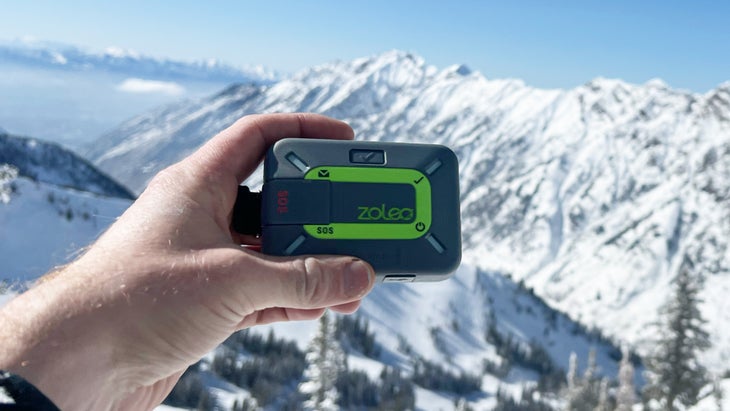
Best Budget
Zoleo Satellite Communicator
Weight: 5.3 oz
Pros and Cons:
⊕ Affordable
⊕ Dedicated phone number
⊗ No screen
⊗ No buttons beyond check-in and SOS
At a relatively low price point, Zoleo lets you send 900+ character messages via a smartphone, unlimited preset check-in messages for free, get weather forecasts, and, of course, send an SOS. The device is screenless, so without a smartphone, you’re limited to one button for preset check-in messages and one for SOS.
Zoleo comes with a dedicated U.S. phone number—like the SPOT X and Bivy Stick—so contacts can initiate messaging with you, as opposed to having to wait to receive a message from you. This number also makes it easier to share the devices with multiple users. If a friend or family member wants to take it out for the day, they don’t need their own account and can simply pair the Zoleo with their own smartphone.
Subscription options are comparable to other devices with 75 monthly messages for $20, 300 for $35, and unlimited for $50. However, you need to pay $6 per month extra to use the Location Share feature, which allows five of your contacts with the Zoleo app to track your location at regular intervals. Tracking is similar to devices like Garmin, just with slower connectivity and in a slightly bulkier package. The Zoleo app, like the device, is basic but solid and reliable.
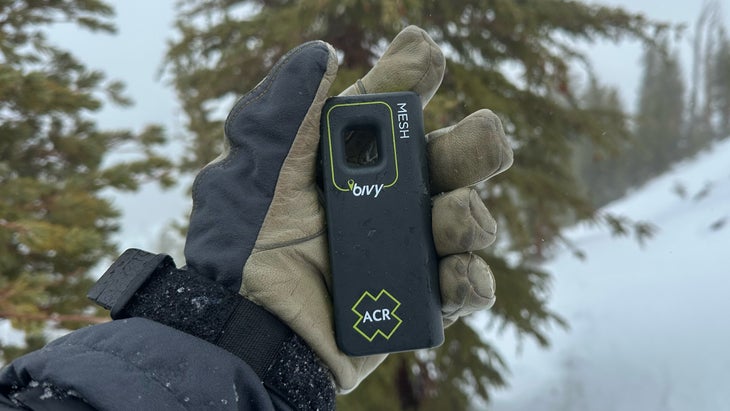
Best for Groups
ACR Bivy Stick Mesh
Weight: 3.75 oz
Pros and Cons:
⊕ LoRa mesh network
⊕ Lightweight and compact
⊗ App is buggy and not intuitive
⊗ SOS button easy to accidentally trigger
As a standalone device, the Bivy Stick functions like most other smartphone-connected satellite messengers, with an SOS trigger and a button to send preset check-ins. What sets it apart is its ability to connect with other Mesh devices in the field via a LoRa (Long Range) decentralized mesh network and communicate with one another via direct messages without cellular coverage up to 10 miles (with a clear line of sight.) Critical for areas with tricky satellite reception, it also allows you to communicate through other hikers’ devices: If one Mesh is stuck in a canyon, but within a few miles of another Mesh with a clear view of a satellite, it can still send and receive messages. And this entire process is automated: the devices finds the clearest path for connection, whether directly through satellite or via other Mesh devices with better reception.
Beyond LoRa communication, the slender, rectangular handheld Mesh allows for group messaging for up to 16 devices, with a map that displays each Mesh user’s location. We had issues with the group messaging feature crashing on us, but are hopeful ACR will continue to refine it. One tester, a PCT thru-hiker and app designer, found the app easy enough to use, but was unimpressed by its non-intuitive layout and visual experience.
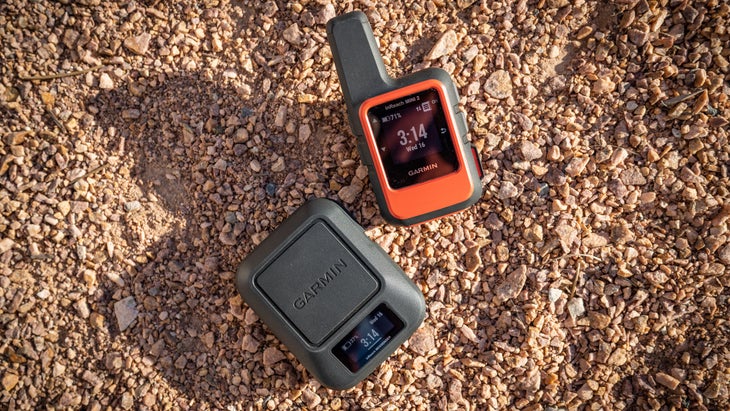
Other Devices We Tested
Garmin inReach Mini 2 ($400): A longtime favorite for backpackers and thru-hikers, the Mini 2 is still a great device and actually weighs roughly 17 grams less than the Messenger Plus. However, it still uses Garmin’s older satellite messaging system, which is limited to 160 characters and unable to send photos and voice memos
Garmin inReach Messenger ($300): Nearly identical in form factor to our top pick, the Messenger Plus, the previous generation of Messenger uses Garmin’s older satellite tech and is unable to send photos and voice memos. It is, however, $200 cheaper.
Garmin GPSMAP 67i ($600): This combo GPS navigator/messenger does everything the Messenger (Gen 1) and Mini 2 can do in terms of communication, but has a 1.5 x 2.5-inch physical screen for navigation and preloaded maps. Unless you specifically need a physical screen, the price tag and weight (8.1 ounces) are hard to swallow for backpacking purposes.
iPhone Satellite Messaging (free): As of iOS 18, anyone with an iPhone 14 or newer has the ability to send text messages via Globalstar satellite. On one hand, it’s free and adds no weight to your pack. On the other, it sucks battery and must be manually aimed at a satellite to send or receive messages. The biggest issue? It only works when the user has absolutely no service: The SOS function only activates in the absence of signal, and satellite messaging can only be enabled when SOS is on. (Airplane mode disables SOS as well.)
How To Choose a Satellite Communicator
How often will you use it?
Only hike once or twice a year? A communicator with flexible short-term subscriptions or a subscription-free device could be the ticket.
Who do you need to keep in touch with?
If you’re regularly talking to loved ones or coordinating with other hikers, a device with two-way messaging (beyond SOS and pre-set missives) and affordable plans makes sense. Using one with a companion smartphone app will save you time and frustration when typing out novels to your significant other.
Are you a Luddite?
For some folks, entering the wilderness is a full-on technology detox. The best way to avoid your smartphone but keep a measure of safety is to buy a dedicated PLB or choose a communicator with a full QWERTY keyboard.
Will you be switching between wilderness (satellite) and civilization (cellular/wifi) with regularity?
Some devices, like the newer Garmin models, will let you seamlessly continue conversations via your device using the app. Others will stop working once you get reception. This is especially important for thru-hikers who make regular resupply runs along the trail.
Where else will you use your device?
If you’re planning to use your communicator while packrafting or crossing a body of water, consider devices that are fully waterproof and float, like the ACR ResQLink, or one with a watertight case, like the full-blown dive-ready enclosure Garmin makes for the InReach Mini 2. Most modern communicators are water-resistant, but might not survive a deep dive in the river.
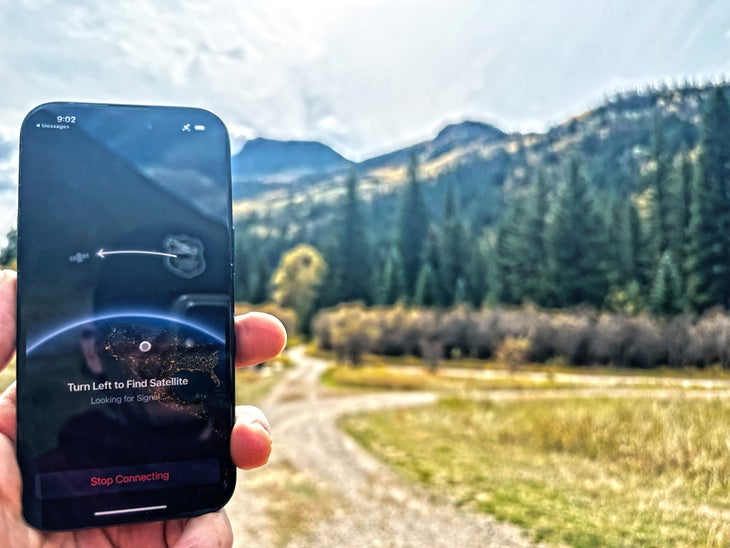
How We Test
- Number of Testers: 5
- Number of devices tested: 7
- Testing Locations: California, Colorado, Oregon, Switzerland, Vermont
- “I’ll Be Late For Dinner” Messages Sent: 5
- Number of Moms Sent The Message “Testing”: 23
We sent our team of testers into the backcountry with an array of satellite communicators to gauge the efficacy of their features, connectivity, and ease of use. We are thru-hikers, backcountry skiers, hunters, and people with friends and families waiting at home. Our testing grounds are California’s Sierra Nevadas, Colorado’s Gore Range, the Pacific Northwest’s Cascade Range, with many side adventures in between. Some of the devices reviewed here are tried-and-true with minimal updates, while others are groundbreaking new technology. All of them have a place on this list.
Meet our Lead Tester
Scott Yorko is a former gear editor for Backpacker, SKI, TransWorld SNOWboarding, and Outside. He lives in Western Colorado, where he splits his ski time between the world-class resorts around Aspen and backcountry terrain in the West Elk Mountains. He loves to chase storms and visit pow-shredding friends, several of whom tested this year’s crop of satellite communication devices.
Related
The Best Backpacking Tents
The Best Backpacking Sleeping Bags
The Best Knives and Multitools